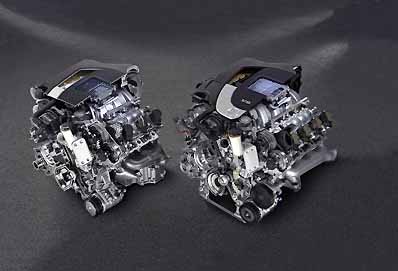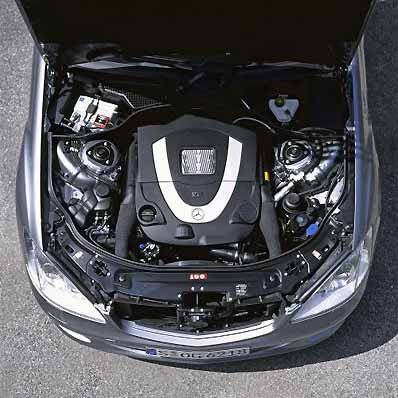
The
Stuttgart-based brand
New six-cylinder
CDI engine and more powerful twelve-cylinder unit from the beginning of
2006

Neuer Sechszylinder-CDI-Motor und stärkerer
Zwölfzylinder ab Anfang 2006 |
The engines in the Mercedes-Benz S-Class
Stuttgart - The
engines for the new Mercedes-Benz S-Class are new or further developments
which offer up to 26 percent more output and up to 15 percent more torque
then the preceding series.
 Fuel consumption is reduced by up to nine percent.
In autumn 2005 a new 5.5-litre eight-cylinder engine developing 285 kW/388
hp will celebrate its world premiere together with the luxury saloon. The
range of outputs from the engines in the S-Class will extend from 173 kW/235
hp in the S 320 CDI to 380 kW/517 hp in the twelve-cylinder S 600. The newly
developed eight-cylinder unit is the top model in the new generation of
Mercedes-Benz V-engines which was successfully introduced in mid-2004. Equipped
with four-valve technology, variably adjustable intake and exhaust camshafts,
a two-stage intake module and tumble flaps in the intake ducts, the new V8
is among the most powerful yet economical engines in its displacement class.
Maximum torque is also significantly improved compared with the previous
V8 engine; it has increased by around 15 percent to 530 Newton metres, and
is available within a wide engine speed range between 2800 and 4800 rpm.
As a result the eight-cylinder powerplant offers driving pleasure more typical
of a sports car. The new S 500 accelerates from zero to 100 km/h in 5.4 seconds
(previous model: 6.3 seconds). Despite the 26 percent higher output, the
NEDC (combined) fuel consumption remains at the level of the preceding model
at 11.7 to 11.9 litres per 100 kilometres. Fuel consumption is reduced by up to nine percent.
In autumn 2005 a new 5.5-litre eight-cylinder engine developing 285 kW/388
hp will celebrate its world premiere together with the luxury saloon. The
range of outputs from the engines in the S-Class will extend from 173 kW/235
hp in the S 320 CDI to 380 kW/517 hp in the twelve-cylinder S 600. The newly
developed eight-cylinder unit is the top model in the new generation of
Mercedes-Benz V-engines which was successfully introduced in mid-2004. Equipped
with four-valve technology, variably adjustable intake and exhaust camshafts,
a two-stage intake module and tumble flaps in the intake ducts, the new V8
is among the most powerful yet economical engines in its displacement class.
Maximum torque is also significantly improved compared with the previous
V8 engine; it has increased by around 15 percent to 530 Newton metres, and
is available within a wide engine speed range between 2800 and 4800 rpm.
As a result the eight-cylinder powerplant offers driving pleasure more typical
of a sports car. The new S 500 accelerates from zero to 100 km/h in 5.4 seconds
(previous model: 6.3 seconds). Despite the 26 percent higher output, the
NEDC (combined) fuel consumption remains at the level of the preceding model
at 11.7 to 11.9 litres per 100 kilometres.
 Technical highlights in the new eight-cylinder engine
also include special shifting camshafts. These reduce the inherent pressure
fluctuations in the exhaust train and thereby considerably improve the engine's
gas cycle. This makes itself felt among other things by smoother running
and higher torque in the lower and medium engine speed ranges. The new Mercedes
eight-cylinder employs the latest lightweight construction principles, with
an aluminium crankcase, low-friction cylinder liners of aluminium/silicon
alloy, a forged steel crankshaft and weight-optimised connecting rods. In
addition to internal exhaust gas recirculation and secondary air injection,
Mercedes-Benz uses two close-coupled catalytic converters with linear oxygen
sensors to ensure low exhaust emissions. Thanks to its up-to-date engine
technology and efficient emission control system, the new eight-cylinder
engine complies with the most stringent exhaust emission standards now in
place, and also has the potential to meet the limits planned for the future. Technical highlights in the new eight-cylinder engine
also include special shifting camshafts. These reduce the inherent pressure
fluctuations in the exhaust train and thereby considerably improve the engine's
gas cycle. This makes itself felt among other things by smoother running
and higher torque in the lower and medium engine speed ranges. The new Mercedes
eight-cylinder employs the latest lightweight construction principles, with
an aluminium crankcase, low-friction cylinder liners of aluminium/silicon
alloy, a forged steel crankshaft and weight-optimised connecting rods. In
addition to internal exhaust gas recirculation and secondary air injection,
Mercedes-Benz uses two close-coupled catalytic converters with linear oxygen
sensors to ensure low exhaust emissions. Thanks to its up-to-date engine
technology and efficient emission control system, the new eight-cylinder
engine complies with the most stringent exhaust emission standards now in
place, and also has the potential to meet the limits planned for the future. |
V6 engine with nine percent lower fuel
consumption
The two six-cylinder engines for the new S-Class are likewise new developments.
The S 350 is powered by the 200 kW/272 hp V6 engine which entered series
production in mid-2004. Compared to the previous V6 petrol engine in the
S-Class, the new high-tech power unit delivers around eleven percent more
output, while saving one litre of fuel per 100 kilometres. The combined NEDC
fuel consumption is 10.1 to 10.3 litres per 100 kilometres. The new S 350
accelerates from zero to 100 km/h in 7.3 seconds, and is therefore 0.3 seconds
faster than its predecessor.
New six-cylinder CDI engine and more
powerful twelve-cylinder unit from the beginning of 2006
From the first quarter of 2006 the new 173-kW/235-hp V6 diesel engine will
be added to the range available for the S-Class. This supersedes the previous
in-line six-cylinder unit of the S 320 CDI, improving output by 15 percent.
Maximum torque is increased from 500 to 540 Newton metres, which is available
between 1600 and 2800 rpm. This up-to-date direct-injection diesel unit is
equipped with third-generation common-rail technology. Its advanced features
include rapid and precise piezo-injectors, as well as a maximum injection
pressure of up to 1600 bar. The maintenance-free particulate filter developed
by Mercedes-Benz is standard equipment in the new S 320 CDI in a number of
countries.
The new top model in the S-Class will also become available from the beginning
of 2006. Thanks to an improved biturbo engine the twelve-cylinder S 600 Saloon
develops an output of 380 kW/517 hp -12 kW/17 hp more than previously. Maximum
torque increases from 800 to 830 Newton metres.
Mercedes-Benz equips the V6 and V8 models in the new S-Class with the unique
7G-TRONIC seven-speed automatic transmission as standard.
| MERCEDES-BENZ news-media,
August 2005 |
BACK TO TOP |
